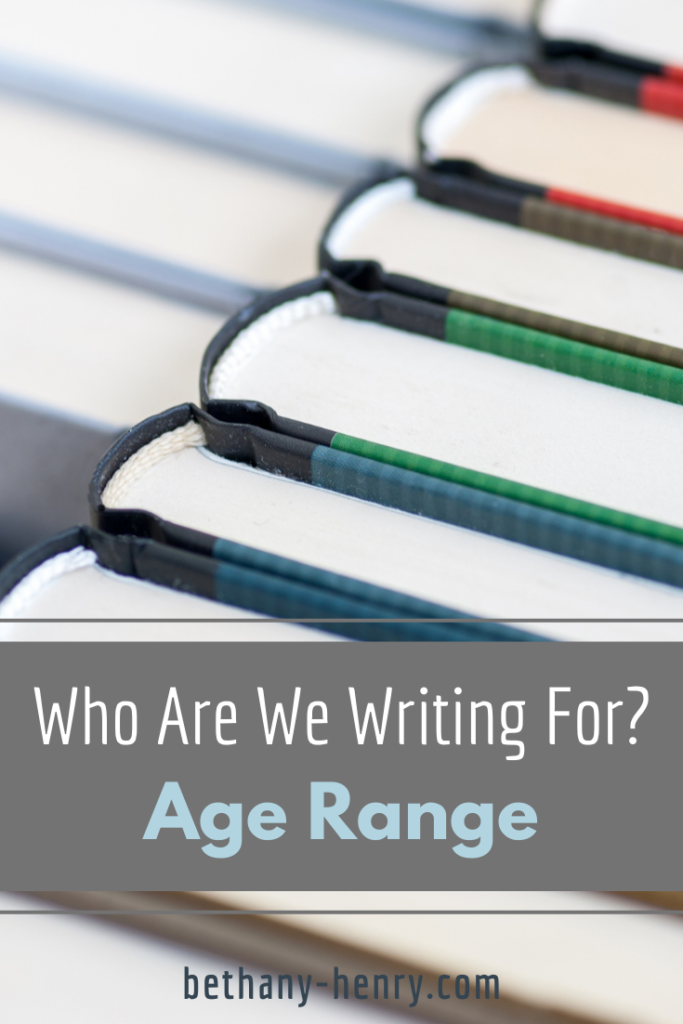Last week I talked about the importance of knowing who we are writing for. We talked about genre and how knowing our genre can give us a foundation to help us create satisfying stories that our readers will find and enjoy.
Another important aspect of knowing who we are writing for is identifying our target age range.

While people read widely and often don’t conform to their actual age when choosing books, stories are generally divided into a few different age levels.
Each of these levels will have different word count targets. This is probably the most obvious difference between them, but there are a few more things that are important to note as well!
We don’t have to follow all the trends to shoehorn our story into a certain category.
But being aware of these differences can help us to identify where and how our story can best be enjoyed by readers.
Age Range in Stories
Board Books
Age range: 0-3
Word count: 0-100 (often under 30)
These books are designed to be read aloud to babies and played with. They should often have engaging pictures and as few words as possible.
Picture Books
Age range: 2-8
Word count: 50-1,000
These stories are a step above board books for babies but are still intended to be read aloud and convey their story heavily through illustrations.
Early/Easy Reader
Age range: 5-9
Word count: 50-2,500
These books are geared for emerging readers. They should have short, simple sentences and uncomplicated story lines.
Chapter/Juvenile Books
Age range: 7-10
Word count: 2,000-10,000
Age of main character: 8-11
POV: generally third person
These stories can be a bit more complicated as the readers grow more independent. Themes like adventure, family life, friendship, mystery, and humor are popular.
Note: Chapter books are almost always part of a series.
MG
Age range: 8-12
Word count: 20,000-50,000
Age of main character: 9-13
POV: either first or third person
Themes of these stories often include fitting in, friendship, family life, and reacting to events or surroundings. They tend to be optimistic and have happy endings.
Writing should be getting more complex here, with plot and character arcs and interesting side characters.
These stories should not contain profanity, graphic violence, or sex. Romance (if any) would probably be a crush or first kiss. Keep it PG.
YA
Age range: 13-18
Word count: 50,000-75,000
Age of main character: 14-15 for younger YA
Age of main character: 16-18 for older YA
POV: often first person or third person limited
Themes frequently include learning to fit into the world, coming to terms with themselves, peer pressure, and romance. Characters should not be in college yet.
Younger YA books will be more innocent and have “cleaner” content, whereas older YA can be grittier and contain more swears, sex, drugs, and violence. (No need to get too gratuitous though- excessive portrayal of these things can turn off your audience and get the book banned from schools and libraries.)
New Adult
Age range: 18-25
Word count: 50,000-75,000
Age of main character: 18-29
Themes often include leaving home, going to college, and exploring sexuality. They may include more explicit content.
Note: New adult is a small/emerging category and these books are sometimes lumped in with YA or general adult categories.
Adult
Age range: 18 and up
Word count: 70,000-120,000
There is a huge range of topics, themes, word counts included here and the expectations vary by genre.
There are, of course, exceptions to every rule. Plenty of books don’t fit these guidelines exactly.
But they are still a good tool to use.
Because knowing where our story fits into both genre and age range categories can help us better connect and resonate with our agents, publishers, and our readers.

For further reading:
YA vs. Middle Grace Fiction: Four Key Differences – Reedsy
The Key Differences Between Middle Grade vs Young Adult – Writers Digest
Understanding Children’s Book Classifications – Author Learning Center
Who Is My Audience? Age Categories for Children’s Books – Fiction University
Age Levels for Children’s Books You Should Know – Journey to KidLit
What about you? Do you find genre and age range categories to be helpful when writing? How about as a reader?




